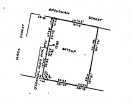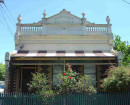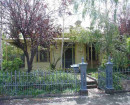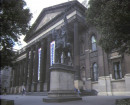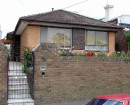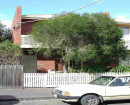Park View
1810 Calder Alternative Highway, MARONG VIC 3515 - Property No 217818
-
Add to tour
You must log in to do that.
-
Share
-
Shortlist place
You must log in to do that.
- Download report
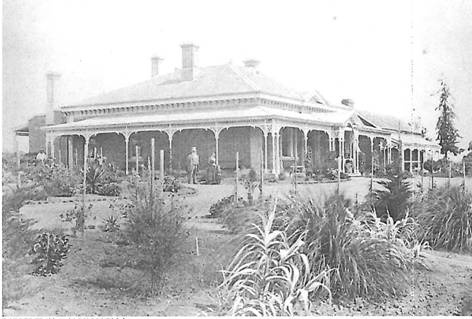

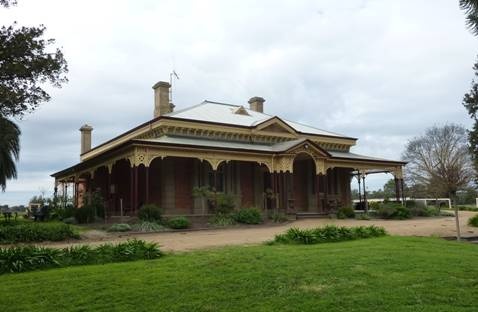
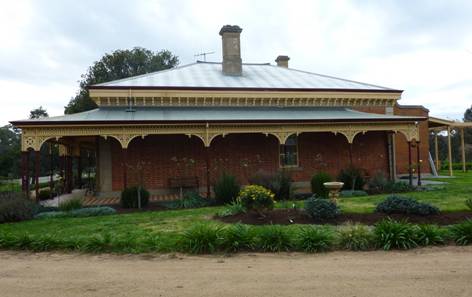
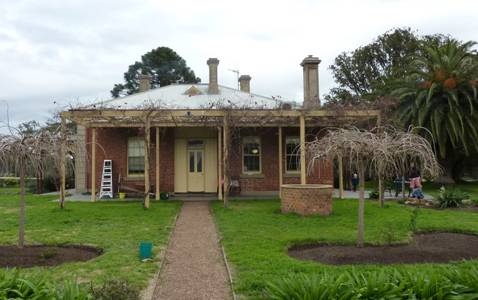
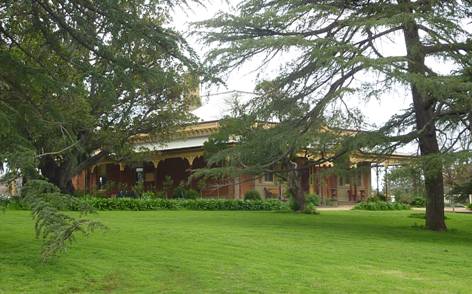
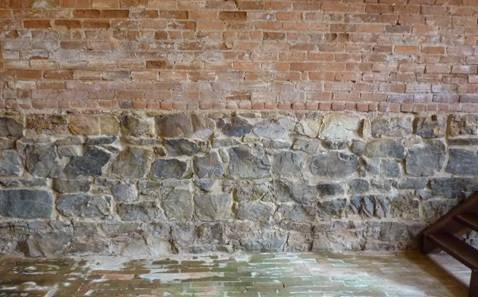
Statement of Significance
What is significant?
Park View, at 1810 Alternative Calder Highway, Marong, comprises an early 1880s symmetrical Italianate villa in landscaped grounds with an outbuilding, possibly dating to the 1860s, at the rear of the main house. It is approached along a gravelled drive, with a timber bridge over Bullock Creek. The house is broadly square in plan, and has a single-hipped roof clad in corrugated galvanised steel, with a gablet vent, a second gable on its rear elevation, four stucco rendered chimneys, and boxed eaves. The west eave is broken by a breakfront pedimented gable above the verandah and on axis with the entrance below. The verandah, which is attached just below the eave bracket line, wraps around three sides, has a concave roof and an iron frieze. The house entrance under the verandah is fronted by an arched breakfront porch. External walls are of exposed red-umber face-brick, the windows being original timber-framed double-hung sashes. The front windows are set in cement-rendered rectangular-plan bays with two narrow sidelights in each, and with cement-rendered apron sills. The front door is treated similarly, but with sidelights set integrally in the door-case. The main corners are in rendered cement and shaped as quoins. The whole building has a circling stone base.
The stone outbuilding at the east of the site may incorporate elements of one of the 1860s outbuildings. This structure has brick with pink and tan-brown colouring characteristic of central Victoria in the 1860s; a rear component dug out to c. 1.5m below grade; and a random (irregular) rubble footing in what appears to be local sedimentary bluestone. The garden layout is on the same general lines seen in the early 1880s photograph. Several trees, including Moreton Bay fig trees, monkey puzzles (araucaria) and other conifers, are long-standing and appear part of the original garden design. Other borders were replanted with agapanthus, a favourite early twentieth century planting.
How is it significant?
Park View is of local historic and aesthetic/architectural significance.
Why is it significant?
Park View is historically significant (Criterion A) for its association with the development of Marong, particularly with later development in the area by a locally notable and prosperous family. It is able to demonstrate an aspect of goldfields life, whereby a relatively small number of affluent families, who typically had made their fortunes in gold, lived in palatial villas in extensive landscaped gardens. The present property (believed to date to the early 1880s) superseded an earlier (1860s) structure at the site, reflecting the increasing wealth of its owner Thomas Glover, who had the resources to commission the design of his house from the prolific and fashionable Bendigo architects, Vahland and Getzschmann. Park View is also significant for its association with the leading Bendigo architectural practice, and is an example of their residential work in an oeuvre which included many important public, civic and commercial buildings in the municipality. The association with Glover is additionally significant; he migrated from Ireland in 1854 and went on to become a local person of note, being a mining speculator, successful farmer and local councillor/politician (Criterion H).
Aesthetically and architecturally (Criterion E), Park View is significant as an example of the work of the noted Bendigo architects. It is a bold, confident design reflecting the opulence of the era and the wealth of owner. It can also be seen as a transitional design, between the last phase of Italianate's dominance in the 1880s and the onset of Federation around 1887-90. The house is largely intact as built and notable elements include the complex verandah frieze including the lacework quadrants; the grouped verandah columns; and the breakfront verandah form. Modifications have generally been of a sympathetic nature. The aesthetic significance of the property is also enhanced by the landscaped garden setting, including the Moreton Bay fig trees, monkey puzzles (araucaria) and other conifers.
-
-
Park View - Physical Description 1
Park View is located on elevated ground overlooking Bullock Creek, to the east of the Alternative Calder Highway, approximately 1km south of Marong. It is approached along a gravelled drive, with a timber bridge over Bullock Creek. The property comprises a late Italianate villa in landscaped grounds with an outbuilding, possibly dating to the 1860s, at the rear.
The main house appears to have begun as a gabled roof building, shown at the right of the archival photograph dated c. 1880 (see page 1). This component has been removed. It had a five-bay verandah springing from just below the main eave line, a timber frieze and posts and a strait-sheeted and quite deep verandah roof. This building component also had a single large chimney visible in the photograph, with a cornice formed from brick courses.
The present house, broadly square in plan, is a later component acting as a frontispiece or improvement to the original, and its detailing and material usage and form are characteristic of the 1880s to early 1890s. The house has a single-hipped roof clad in corrugated galvanised steel, with a gablet vent, a second gable on its rear elevation, and boxed eaves with consistently spaced cyma recta brackets. The eave has several small trefoliated panels inset. There are four chimneys, each stucco rendered, with articulated pedestal bases, stacks with incised panel outlines and cornices. The west eave is broken by a breakfront pedimented gable, with timber bargeboard-cornice, a timber architrave and a deeply recessed tympanum with a circular vent. The verandah is attached just below the eave bracket line and has a concave roof clad in corrugated galvanised steel over a timber frame. The verandah frieze and its iron panels appear long-standing as materials but the verandah structure itself has been rebuilt. The house entrance under the verandah is fronted by an arched breakfront porch comprising a large central arch and six narrow stilted arches as flanking components. At each verandah corner the columns are paired and support another two of these stilted arches in the lacework frieze. The pedimented roof gable is on axis with (and above) the front door. The flanking verandah frieze comprises panels of interlinked arch-pattern lacework with inverted finials and lacework quadrant brackets at the column junctions. The verandah columns appear original and are stamped Angus McLean, Patentee, Ironfounder, Post Office Place, Melbourne. The verandah floor tiling and cement bedding has been re-laid.
The external walls are of exposed red-umber face-brick, the windows being original timber-framed double-hung sashes and, at the sides and rear these are on simple basalt block sills. The main corners are in rendered cement and shaped as quoins. The front elevation is symmetrical. The north elevation has two windows placed towards the east, the south elevation has a single window also towards the east and the rear, kitchen elevation has four evenly spaced openings, a door and three windows. The front windows are set in cement-rendered rectangular-plan bays with two narrow sidelights in each, and with cement-rendered apron sills. The front door is treated similarly, but the sidelights are set integrally in the door-case and the door-case is in turn set between two cement-rendered piers. The whole building has a circling stone base, including the kitchen elevation and its chimney-breast flank. This is expressed as independent of the main hipped roof, having a skillion roof set between parapet walls with cement-rendered coping. The kitchen chimney-breast is expressed externally as a slight breakfront in the brick walling, supporting a cement rendered chimney pedestal running partway down the wall. The archival photograph shows this lesser elevation as original, attached to a high-mounted timber-framed verandah to the rear; the latter has been replaced with a deeper skillion verandah linked to a pergola.
The house appears to be in generally sound condition, with some evidence of structural movement. Recent restoration and refurbishment works have been carried out to a high standard, and are generally sympathetic to the original design.
Outbuildings
A stone outbuilding at the east of the site, recently refurbished and extended, may incorporate elements of one of the 1860s outbuildings. This structure, whose rear component has a floor dug c. 1.5m below grade, has a random (irregular) rubble footing in what appears to be local sedimentary bluestone (not basalt), with a plate of headers giving way to stretcher bond in a six-course layer capped by another course of headers. The brick here is of the pink and tan-brown characteristic of central Victoria in the 1860s, as is the brick floor below the stone footing.
Garden
The garden layout is on the same general lines seen in the 1880s photograph. The original stone kerbs have been removed, as has the side gravel drive, with its curving entry. The verandah garden on the entry side (west) has been straightened out in its perimeter profile and the rounded garden on the further side has been left in similar shaping to that seen in the 1880s photograph. Several trees, including Moreton Bay fig trees, monkey puzzles (araucaria) and other conifers, are long-standing and appear part of the original garden design. Other borders were replanted with agapanthus, a favourite early twentieth century planting.
Heritage Study and Grading
Greater Bendigo - Heritage Policy Citations Review
Author: Lovell Chen P/L
Year: 2011
Grading: Local
-
-
-
-
-
Park View
 Greater Bendigo City
Greater Bendigo City
-
'Lawn House' (Former)
 Hobsons Bay City
Hobsons Bay City -
1 Fairchild Street
 Yarra City
Yarra City -
10 Richardson Street
 Yarra City
Yarra City
-
-




